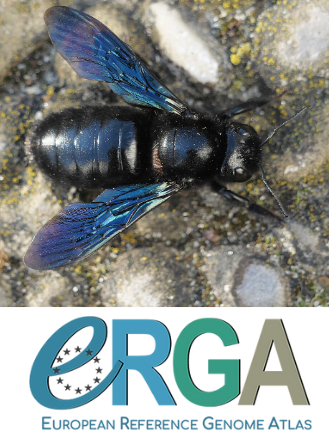Recommendation: 1

The genome sequence of the Violet Carpenter Bee, Xylocopa violacea (Linnaeus, 1785): a hymenopteran species undergoing range expansion
A high-quality genome assembly for carpenter bees
Recommended by Christian Lopezguerra and Gavin DouglasChristian Lopezguerra (1) and Gavin M. Douglas (2, 3)
(1) Department of Plant and Microbial Biology; (2) Department of Biological Sciences; (3) Bioinformatics Research Center, North Carolina State University, USA
Climate change and anthropogenic stressors are driving rapid biodiversity loss and dynamic shifts in species ranges (Outhwaite et al. 2022). Partially in response to the decline in biodiversity, the European Reference Genome Atlas (ERGA) has been generating high-quality accessible genome resources, allowing for a more collaborative network and assisting conservation efforts.
One recent target was the violet carpenter bee (Xylocopa violacea; Figure 1), one of the many insects that have shown a recent expansion in their range within Europe. This species is a key pollinator and is therefore of great interest for ecological and agricultural purposes. In addition, anticancer research with melittin variants present in the venom of the violet carpenter bee shows potential (Erkoc et al. 2022; von Reumont et al. 2022). However, genetic analyses have been limited by the prior contig-level assembly of the genome (Koludarov et al. 2023). Developing a high-quality, annotated reference genome for the carpenter bee was the goal of Nash and colleagues’ (2024) research, as part of the European Reference Genome Atlas initiative.

Figure 1: Violet carpenter bee (in Margarida, Spain). Copyright Susanne Vogel, a photographer who made this available on iNaturalist.com. Distributed under a CC-BY 4.0 license.
The authors coupled long and short-read sequencing techniques to create an improved assembly. In particular, they used both short-read RNA-seq and long-read Iso-Seq for gene annotation. They also used Hi-C sequencing to capture chromosome conformational information to aid scaffolding. Their final assembly contains 1,300 scaffolds and has a BUSCO completeness level of 99.75% (Manni et al. 2021), aligning with the standards of the European Reference Genome Atlas. The authors generated a 1.02 gigabase assembly, which was much larger than the expected size of 672 megabases based on k-mer content. The authors partially explain the difference by the high repeat content in the genome, particularly specific 109-mer and 217-mer repeats. Due to this high repeat content, the authors could not assemble full chromosomes but instead produced 17 pseudo-chromosomes comprised of 481.4 megabases (in addition to all other unlocalized scaffolds).
This high-quality reference genome will be valuable for future studies on population and functional genomics of carpenter bees (Xylocopa). Indeed, this is the first high-quality annotated pseudo-chromosomal genome assembly of the genus Xylocopa, which includes hundreds of other species. It will enable improved investigation into genomic signatures associated with shifting populations. More generally, this reference genome will be useful for comparative analyses with other Hymenoptera species.
References
Erkoc P, von Reumont BM, Lüddecke T, Henke M, Ulshöfer T, Vilcinskas A, Fürst R, Schiffmann S (2022) The pharmacological potential of novel melittin variants from the honeybee and solitary bees against inflammation and cancer. Toxins, 14, 818. https://doi.org/10.3390/toxins14120818
Koludarov I, Velasque M, Senoner T, Timm T, Greve C, Hamadou AB, Gupta DK, Lochnit G, Heinzinger M, Vilcinskas A, Gloag R, Harpur BA, Podsiadlowski L, Rost B, Jackson TNW, Dutertre S, Stolle E, von Reumont BM (2023) Prevalent bee venom genes evolved before the aculeate stinger and eusociality. BMC Biology, 21, 229. https://doi.org/10.1186/s12915-023-01656-5
Manni M, Berkeley MR, Seppey M, Simão FA, Zdobnov EM (2021) BUSCO update: Novel and streamlined workflows along with broader and deeper phylogenetic coverage for scoring of eukaryotic, prokaryotic, and viral genomes. Molecular Biology and Evolution, 38, 4647–4654. https://doi.org/10.1093/molbev/msab199
Nash WJ, Man A, McTaggart S, Baker K, Barker T, Catchpole L, Durrant A, Gharbi K, Irish N, Kaithakottil G, Ku D, Providence A, Shaw F, Swarbreck D, Watkins C, McCartney AM, Formenti G, Mouton A, Vella N, von Reumont BM, Vella A, Haerty W (2024) The genome sequence of the Violet Carpenter Bee, Xylocopa violacea (Linnaeus, 1785): a hymenopteran species undergoing range expansion. Heredity, 133, 381–387. https://doi.org/10.1038/s41437-024-00720-2
Outhwaite CL, McCann P, Newbold T (2022) Agriculture and climate change are reshaping insect biodiversity worldwide. Nature, 605, 97–102. https://doi.org/10.1038/s41586-022-04644-x
von Reumont BM, Dutertre S, Koludarov I (2022) Venom profile of the European carpenter bee Xylocopa violacea: Evolutionary and applied considerations on its toxin components. Toxicon: X, 14, 100117. https://doi.org/10.1016/j.toxcx.2022.100117

